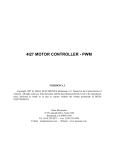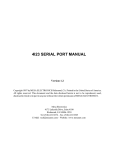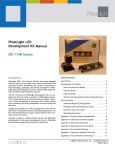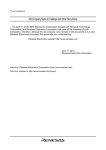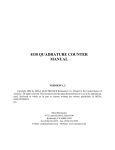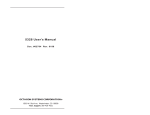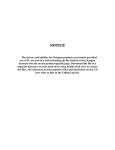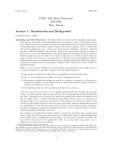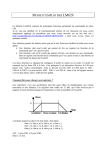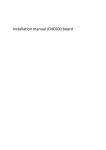Download manual - Mesa Electronics
Transcript
4I28 MOTOR CONTROLLER VERSION 1.0 Copyright 2001 by MESA ELECTRONICS Richmond, CA. Printed in the United States of America. All rights reserved. This document and the data disclosed herein is not to be reproduced, used, disclosed in whole or in part to anyone without the written permission of MESA ELECTRONICS. Mesa Electronics 4175 Lakeside Drive, Suite #100 Richmond, CA 94806-1950 Tel (510) 223-9272 - Fax (510) 223-9585 E-Mail: [email protected] - Website: www.mesanet.com 4I28 USER’S MANUAL 4I28 USER’S MANUAL TABLE OF CONTENTS WARNINGS Servo hazards . . . . . . . . . . . . . . . . . . . . . . . . . . . . . . . . . . . . . . . . . . . . . . . . . . . . . . . . . . . . . . . . . . . . . . . . . 4 Handling precautions . . . . . . . . . . . . . . . . . . . . . . . . . . . . . . . . . . . . . . . . . . . . . . . . . . . . . . . . . . . . . . . . . . 4 INTRODUCTION General . . . . . . . . . . . . . . . . . . . . . . . . . . . . . . . . . . . . . . . . . . . . . . . . . . . . . . . . . . . . . . . . . . . . . . . . . . . . . . . . 5 HARDWARE CONFIGURATION General . . . . . . . . . . . . . . . . . . . . . . . . . . . . . . . . . . . . . . . . . . . . . . . . . . . . . . . . . . . . . . . . . . . . . . . . . . . . . . . . Default configuration . . . . . . . . . . . . . . . . . . . . . . . . . . . . . . . . . . . . . . . . . . . . . . . . . . . . . . . . . . . . . . . . . . Port address. . . . . . . . . . . . . . . . . . . . . . . . . . . . . . . . . . . . . . . . . . . . . . . . . . . . . . . . . . . . . . . . . . . . . . . . . . . . Interrupt select . . . . . . . . . . . . . . . . . . . . . . . . . . . . . . . . . . . . . . . . . . . . . . . . . . . . . . . . . . . . . . . . . . . . . . . . . I/O pullups/pulldowns . . . . . . . . . . . . . . . . . . . . . . . . . . . . . . . . . . . . . . . . . . . . . . . . . . . . . . . . . . . . . . . . . 6 6 6 8 8 INTERFACE CONNECTOR General . . . . . . . . . . . . . . . . . . . . . . . . . . . . . . . . . . . . . . . . . . . . . . . . . . . . . . . . . . . . . . . . . . . . . . . . . . . . . . . . 9 I/O connector orientation . . . . . . . . . . . . . . . . . . . . . . . . . . . . . . . . . . . . . . . . . . . . . . . . . . . . . . . . . . . . . . 9 Interface connector pinout . . . . . . . . . . . . . . . . . . . . . . . . . . . . . . . . . . . . . . . . . . . . . . . . . . . . . . . . . . . . . 9 INSTALLATION General . . . . . . . . . . . . . . . . . . . . . . . . . . . . . . . . . . . . . . . . . . . . . . . . . . . . . . . . . . . . . . . . . . . . . . . . . . . . . . . 10 OPERATION Register map . . . . . . . . . . . . . . . . . . . . . . . . . . . . . . . . . . . . . . . . . . . . . . . . . . . . . . . . . . . . . . . . . . . . . . . . . . 11 Parallel port . . . . . . . . . . . . . . . . . . . . . . . . . . . . . . . . . . . . . . . . . . . . . . . . . . . . . . . . . . . . . . . . . . . . . . . . . . . 11 Parallel port bits . . . . . . . . . . . . . . . . . . . . . . . . . . . . . . . . . . . . . . . . . . . . . . . . . . . . . . . . . . . . . . . . . . . . . . 12 Parallel port operation . . . . . . . . . . . . . . . . . . . . . . . . . . . . . . . . . . . . . . . . . . . . . . . . . . . . . . . . . . . . . . . . 13 Interrupt mask register . . . . . . . . . . . . . . . . . . . . . . . . . . . . . . . . . . . . . . . . . . . . . . . . . . . . . . . . . . . . . . . . 13 Interrupt status register . . . . . . . . . . . . . . . . . . . . . . . . . . . . . . . . . . . . . . . . . . . . . . . . . . . . . . . . . . . . . . . 13 Common command mask register . . . . . . . . . . . . . . . . . . . . . . . . . . . . . . . . . . . . . . . . . . . . . . . . . . . . . 14 Connecting motors . . . . . . . . . . . . . . . . . . . . . . . . . . . . . . . . . . . . . . . . . . . . . . . . . . . . . . . . . . . . . . . . . . . 14 Servo system tuning . . . . . . . . . . . . . . . . . . . . . . . . . . . . . . . . . . . . . . . . . . . . . . . . . . . . . . . . . . . . . . . . . . . 15 Demonstration programs . . . . . . . . . . . . . . . . . . . . . . . . . . . . . . . . . . . . . . . . . . . . . . . . . . . . . . . . . . . . . 16 REFERENCE INFORMATION Specifications . . . . . . . . . . . . . . . . . . . . . . . . . . . . . . . . . . . . . . . . . . . . . . . . . . . . . . . . . . . . . . . . . . . . . . . . . 18 Warranty. . . . . . . . . . . . . . . . . . . . . . . . . . . . . . . . . . . . . . . . . . . . . . . . . . . . . . . . . . . . . . . . . . . . . . . . . . . . . . 19 4I28 USER’S MANUAL WARNINGS SERVO WARNING Large servo motors are capable of inflicting serious injury both to people and to mechanisms associated with the servo system. In addition, some motors use potentially lethal supply voltages. When a servo control system is first configured, unpredictable behavior should be EXPECTED. First time checks of basic servo operation (such as motor position versus drive) should be checked with the motor power leads disconnected. Never depend on software commands to the 4I28 to disable the motor when you or others would be exposed to a hazard should the motor start unexpectedly. Motor power should always be removed when working on mechanical parts of the servo system. STATIC ELECTRICITY The CMOS integrated circuits on the 4I28 can be damaged by exposure to electrostatic discharges. The following precautions should be taken when handling the 4I28 to prevent possible damage. A. Leave the 4I28 in its antistatic bag until needed. B. All work should be performed at an antistatic workstation. C. Ground equipment into which 4I28 will be installed. D. Ground personnel with conductive bracelet through 1 megohm resistor to ground. E. Avoid wearing synthetic fabrics, particularly Nylon. Page 4 4I28 USER’S MANUAL INTRODUCTION GENERAL The 4I28 is a low cost, LM629 based 4 axis DC servo motor control system implemented on a stackable PC/104 bus card. The 4I28 is designed for high performance positioning systems using DC servo motors with quadrature shaft encoders. The per axis output of the 4I28 is an 8 bit sign-magnitude PWM signal that can drive H-bridge type servo amplifiers directly. TTL inputs are conditioned with RC filters and Schmitt triggers for noise immunity. The 4 axis 4I28 can be use with 2 Mesa 7I25 or 7I27 2 axis HBridges using the supplied 4I28 adapter. Control signals for each axis include 8 auxiliary I/O bits. Sixteen general purpose I/O bits are available for any application use. The LM629’s used on the 4I28 are high performance digital processors specifically designed for motion control. The LM629 can execute a ramp-up, slew, and ramp-down motion sequence without host processor intervention. Host interrupts can be generated at end of motion, position breakpoints, index pulse, or in response to various error conditions. Interrupts are or’ed on the 4I28 card, so that only one system interrupt is used. IRQs 9,5,10,11, or 12 can be selected with jumpers on the 4I28 card. A digital PID filter is used to set loop feedback parameters for stability and optimum performance. Velocity, target position and filter parameters may be changed during motion. Demonstration software includes examples of 2 axis position mode operation, velocity mode operation, and a simple filter tuning program that allows dynamic filter coefficient modification while providing a graphic display of the servo system step response. Source code is provided for all demonstration software. Page 5 4I28 USER’S MANUAL HARDWARE CONFIGURATION GENERAL The 4I28 has only two hardware configurable options, the I/O port address, and the Interrupt. The options are selected with shorting jumpers placed on three pin headers. In the following discussions, when the words "up", "down", "right", and "left" are used it is assumed that the 4I28 card is oriented with its bus connectors J1 and J2 at the bottom edge of the card (nearest the person doing the configuration). DEFAULT CONFIGURATION The 4I28 card is configured in the following manner when shipped from the factory. FUNCTION DEFAULT JUMPERS POSITION PORT ADDRESS INTERRUPT I/O PULL-U/D 0200H NONE PULL-UP W1 W2-W7 W8 DOWN W7 IN LEFT Demonstration programs shipped with the 4I28 depend on the port address being left at the default setting PORT ADDRESS The 4I28 occupies 16 contiguous locations in I/O space. The base address of the 4I28 card can be set to 2 different locations. These locations are selected with shorting jumpers placed on jumper block W1. The following table shows the I/O base addresses selected by W1: ADDRESS W1 0220H 0230H DOWN UP Page 6 4I28 USER’S MANUAL HARDWARE CONFIGURATION DEFAULT JUMPER SETTINGS Page 7 4I28 USER’S MANUAL HARDWARE CONFIGURATION INTERRUPT SELECT Jumpers blocks W2 through W7 are used to select the interrput generated by the 4I28 card. If interrupts are not used, they should be disabled by moving the jumpers to the W7 position. The following table shown how to select the desired interrupt: IRQ W2 W3 W4 W5 W6 W7 2/9 5 10 11 12 NONE IN NONE NONE NONE NONE NONE NONE IN NONE NONE NONE NONE NONE NONE IN NONE NONE NONE NONE NONE NONE IN NONE NONE NONE NONE NONE NONE IN NONE NONE NONE NONE NONE NONE IN I/O PULLUPS The 4I28’s I/O bits come from an 82C55 chip, and default to inputs at power up. For some interface signals , it is important to have a defined logic state at power up. This defined state is determined by pullup/pulldown resistors connected to the I/O bits. The default setting is to have pullup resistors the I/O bits so at power up, they will default to a high state. This is done by setting W8 to the left hand position. This is needed so that the 7I27 and 7I25 HBridges are disabled at power up. In some cases a low signal may be desired on the I/O bits at powerup. This can be accomplished by moving W8 to the right hand position. Page 8 4I28 USER’S MANUAL INTERFACE CONNECTOR GENERAL The I/O interface connector on the 4I28 is a 50 pin header. The suggested mating connector is AMP PN 1-746285-0. The 4I28 can connect to two 7I25 or two 7I27 HBridges if used with the 4I28 adapter (supplied with the 4I28) I/O CONNECTOR ORIENTATION The 50 pin connector on the 4I28 has the pin one end marked with a white square on the circuit card. This corresponds with the red stripe on typical flat cable assemblies. INTERFACE CONNECTOR PINOUT PIN# 1 3 5 7 9 11 13 15 17 19 21 23 25 27 29 31 33 35 37 39 41 43 45 47 49 SIGNAL +5V BIT1 BIT3 BIT5 BIT7 BIT9 BIT11 BIT13 BIT15 QA0 IDX0 PWM0 GND QB1 /ENA1 DIR1 QA2 IDX2 PWM2 GND QB3 /ENA3 DIR3 BIT16 BIT18 PIN# 2 4 6 8 10 12 14 16 18 20 22 24 26 28 30 32 34 36 38 40 42 44 46 48 50 Page 9 SIGNAL BIT0 BIT2 BIT4 BIT6 BIT8 BIT10 BIT12 BIT14 GND QB0 /ENA0 DIR0 QA1 IDX1 PWM1 GND QB2 /ENA2 DIR2 QA3 IDX3 PWM3 GND BIT17 BIT19 4I28 USER’S MANUAL INSTALLATION GENERAL When the 4I28 has been properly configured for its application, it can be inserted into a PC/104 stack. The standoffs should then be tightened to secure the 4I28 in its place. When the 4I28 is secured in the stack the I/O connector can be plugged in from the side. Page 10 4I28 USER’S MANUAL OPERATION REGISTER MAP The 4I28 occupies 16 contiguous I/O port locations starting at the user selected base address. BASE +00H BASE +01H BASE +02H BASE +03H BASE +04H BASE +05H BASE +06H BASE +07H BASE +08H BASE +09H BASE +0AH BASE +0CH BASE +0DH BASE +0EH BASE +0FH Motor 0/common Command/Status port Motor 0/common Data port Motor 1 Command/Status port Motor 1 Data port Motor 2 Command/Status port Motor 2 Data port Motor 3 Command/Status port Motor 3 Data port Interrupt mask register Interrupt status register Common command mask register 82C55 Port A (must be output) 82C55 Port B (user defined) 82C55 Port C (user defined) 82C55 Control port PARALLEL PORT A 82C55 parallel port is supplied to control the enables for the Hbridges and to provide 20 general purpose I/O bits. The motor control bits are designed to interface with the Mesa 7I25/7I27 H-Bridge driver and the supplied software, otherwise these bits can be used for any purpose. Page 11 4I28 USER’S MANUAL OPERATION PARALLEL PORT BITS 82C55 PORT BIT PIN FUNCTION A A A A A A A A 0 1 2 3 4 5 6 7 22 29 36 43 47 48 49 50 /Motor 0 enable /Motor 1 enable /Motor 2 enable /Motor 3 enable Bit 16 Bit 17 Bit 18 Bit 19 B B B B B B B B 0 1 2 3 4 5 6 7 2 3 4 5 6 7 8 9 Bit 0 Bit 1 Bit 2 Bit 3 Bit 4 Bit 5 Bit 6 Bit 7 C C C C C C C C 0 1 2 3 4 5 6 7 10 11 12 13 14 15 16 17 Bit 8 Bit 9 Bit 10 Bit 11 Bit 12 Bit 13 Bit 14 Bit 15 Page 12 4I28 USER’S MANUAL OPERATION PARALLEL PORT OPERATION The parallel ports on the 4I28 use a standard 82C55 PIA. The user accessible I/O lines have 3.3K pullup/pulldown resistors to simplify interfacing to contact closure, opto-detector or open collector outputs. Port A is used for Motor enable on the 7I25 and 7I27 Hbridges so must be set to output mode. Port B and C can be used for input or output. Port C has the feature of being splitable into two 4 bit ports to allow both input and output bits on the same port. INTERRUPT MASK REGISTER The four LM629 motor controller chips on the 4I28 have their interrupts OR’ed together in the 4I28 control logic, so any individual axis interrupt can generate a system interrupt. Individual interrupts are masked in the interrupt mask register before being OR’ed together and presented to the system. The interrupt mask register is a read/write register. A one bit in the interrupt mask register enables the correponding axis’s interrupt, and a zero bit disable thats axis’s interrupt. Bit 4 of the Interrupt mask register is the IRQEN bit. If the IRQEN bit is clear, the IRQ driver pin on the 4I28 is tri-stated. BIT7 BIT6 BIT5 BIT4 BIT3 BIT2 BIT1 BIT0 XX XX XX IRQEN IMASK3 IMASK2 IMASK1 IMASK0 INTERRUPT STATUS REGISTER The 4 per axis interrupts can be monitored via the read-only interrupt status register. Bit 4 of the interrupt status register is set if any 4I28 interrupt is active. BIT7 BIT6 BIT5 BIT4 BIT3 BIT2 BIT1 BIT0 XX XX 0 ANYIRQ AX3IRQ AX2IRQ AX1IRQ AX0RQ Page 13 4I28 USER’S MANUAL OPERATION COMMON COMAND MASK REGISTER To reduce the overhead when starting multiple axis moves, the 4I28 has the ability to issue commands to more than one axis at at time. This would typically be used with the start-trajectory command. The common command register is a read/wrie register. A 1 bit the the register will enable command directed at axis 0 to write to the cooresponding axis in addition to axis 0. The common command registershould be cleared to a 0 after use so that it will not interfere with per-channel readback data BIT7 BIT6 BIT5 BIT4 BIT3 BIT2 BIT1 BIT0 XX XX 1 1 COMM3 COMM2 COMM1 XX CONNECTING MOTORS After the 4I28 has been configured and installed in the system, it should be checked for correct operation. The supplied programs 4I28READ, and 4I28HOLD can be used as a quick check of 4I28 functionality. The first step is to connect the 4I28 to the quadrature encoder(s) and then use 4I28READ to check for functionality and proper count direction (to match the coordinates of your positioning system). The program 4I28READ simply prints both motor positions (relative to their position at program initialization) continuously until a key is pressed. If the count direction is reversed, switch the encoder A and B outputs to the 4I28. For the next step, It is suggested that the motor drive leads be left disconnected, and 4I28HOLD be run. When 4I28HOLD is run, it will check for the presence of the 4I28, and enable all motors. All motors will be configured for position mode with the home position being set to wherever the motors happen to be during program initialization. The PWM outputs of the 4I28 or the H-Bridge can then be monitored while the motor is manually ’rocked’back and forth from its original position. If the 4I28 is operating correctly, the DIR and PWM outputs should vary with encoder shaft position. If the 4I28 is used with a 7I25/7I27 H-Bridge, the 7I25/7I27 output LEDs can be used as indicators of power drive direction and magnitude. A green LED color on a 7I25/7I27 indicates a positive polarity on pin 1 of the motor drive terminal strip. In this way, it is possible to determine the correct motor drive polarity. The motor(s) should be connected such that the motor drive would tend to oppose the hand generated motor motion. Page 14 4I28 USER’S MANUAL OPERATION SERVO SYSTEM TUNING A simple manual tuning program, 4I28TUNE, is supplied with the 4I28. This program allows you to manually adjust the digital filter parameters while the selected motor is in operation. In addition, 4I28TUNE can record the step response of the servo system with the current set of filter parameters. 4I28TUNE uses the cursor keys to select the desired parameter, and adjust that parameter. The selectable parameters are as follows: PARAMETER DESC. RANGE UNITS KP KD KI IL SI STEP SIZE VELOCITY ACCELERATION MOTOR TIME / DIV gain damping integral integral limit sample interval motor step velocity acceleration selects motor selects graph 0 to 32767 0 to 32767 0 to 32767 0 to 32767 0 to 255 100 to 10000 0 to 1073741823 0 to 1073741823 0 and 1 10 to 200 drive/err drive/err(n)-error(n-1) drive/accum. error KI contribution limit SP/(SI+1) encoder counts encoder counts/SP encoder counts/ SP/ SP milliseconds/division SP = SAMPLING PERIOD = 256 uSec * (1+SI) with 8 MHz clock. The following table shows the 4I28TUNE key functions. KEY FUNCTION UP ARROW DOWN ARROW RIGHT ARROW LEFT ARROW PAGE DOWN END PAGE UP INSERT DELETE CTRL HOME ALT X select parameter select parameter adjust parameter up fast (+10%) adjust parameter down fast (-10%) adjust parameter up slow (+1%) adjust parameter down slow (-1%) draw horizontal timing scale do step and record response clear graph reset parameters to initial values (current motor only) exit program Page 15 4I28 USER’S MANUAL OPERATION DEMONSTRATION PROGRAMS 4I28VELO sets motor 0 and motor 1 into the velocity mode and allows you to set their speeds in RPM. 4I28POS does some random 2 axis moves with pairs of motors. 4I28VELO and 4I28POS may need to have their default filter parameters and other constants changed to match your motors and card location before being run. 4I28TUNE is a manual parameter tuning program that allows you to optimize filter parameters while the selected motor is in operation. 4I28TUNE requires an EGA, VGA or Hercules compatible video adaptor card for operation. All of the demonstration programs are written in Turbo Pascal. The source code for the demonstration programs is provided in the source directory of the 4I28 distribution disk. Page 16 4I28 USER’S MANUAL Page 17 4I28 USER’S MANUAL REFERENCE INFORMATION SPECIFICATIONS MIN MAX UNIT NOTES POWER SUPPLY Voltage Supply current 4.5 --- 5.5 250 V mA (no ext load) BUS LOADING: Input capacitance Input leakage current Output drive capability Output sink current ----150 12 15 5 ----- pF uA pF mA I/O PORT LOADING: Input logic low Input logic high Output low Output high -.3 2.0 ---3.0 .8 5.5 .4 --- V V V V ENVIRONMENTAL: Operating temperature range -I version -C version Relative humidity -40 0 0 +85 +70 90 o Page 18 2.5 mA sink 2.5 mA source C C Percent Non-condensing o 4I28 USER’S MANUAL REFERENCE INFORMATION WARRANTY Mesa Electronics warrants the products it manufactures to be free effects in material and workmanship under normal use and service for the period of 2 years from date of purchase. This warranty shall not apply to products which have been subject to misuse, neglect, accident, or abnormal conditions of operation. In the event of failure of a product covered by this warranty, Mesa Electronics, will repair any product returned to Mesa Electronics within 2 years of original purchase, provided the warrantor’s examination discloses to its satisfaction that the product was defective. The warrantor may at its option, replace the product in lieu of repair. With regard to any product returned within 2 years of purchase, said repairs or replacement will be made without charge. If the failure has been caused by misuse, neglect, accident, or abnormal conditions of operation, repairs will be billed at a nominal cost. THE FOREGOING WARRANTY IS IN LIEU OF ALL OTHER WARRANTIES, EXPRESS OR IMPLIED. INCLUDING BUT NOT LIMITED TO ANY IMPLIED WARRANTY OF MERCHANTABILITY, FITNESS, OR ADEQUACY FOR ANY PARTICULAR PURPOSE OR USE. MESA ELECTRONICS SHALL NOT BE LIABLE FOR ANY SPECIAL, INCIDENTAL, OR CONSEQUENTIAL DAMAGES, WHETHER IN CONTRACT, TORT, OR OTHERWISE. If any failure occurs, the following steps should be taken: 1. Notify Mesa Electronics, giving full details of the difficulty. On receipt of this information, service data, or shipping instructions will be forwarded to you. 2. On receipt of the shipping instructions, forward the product, in its original protective packaging, transportation prepaid to Mesa Electronics. Repairs will be made at Mesa Electronics and the product returned transportation prepaid. Page 19 4I28 USER’S MANUAL REFERENCE INFORMATION SCHEMATICS Page 20




















